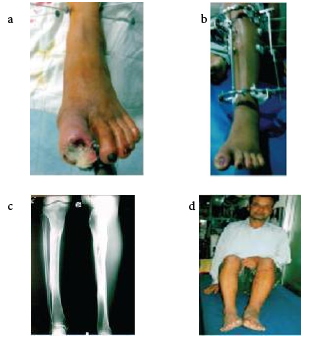MOJ
eISSN: 2374-6939


Research Article Volume 3 Issue 4
1Chief Consultant, Bari-Ilizarov Orthopaedic Centre, Visiting and Honored Prof., Russian Ilizarov Scientific Centre, Russia
2Bari-Ilizarov Orthopaedic Centre, Bangladesh
3Jessore Medical College & Hospital, Bangladesh
Correspondence: Mofakhkharul Bari, Chief Consultant, Bari-Ilizarov Orthopaedic Centre, Visiting and Honored Professor, Russian Ilizarov Scientific Centre, Kurgan, Tel +88 01819 211595
Received: October 08, 2015 | Published: October 15, 2015
Citation: Bari MM, Islam S, Rouf AHMA, Rahman M (2015) Management of Buerger’s Disease (Tao) With Ilizarov (A Retrospective Study of 18 Cases). MOJ Orthop Rheumatol 3(4): 00099. DOI: 10.15406/mojor.2015.03.00099
Buerger’s Disease (Thrombo Angiitis Obliterans- TAO) is an episodic, segmental inflammatory thrombotic disease that most commonly affects the arteries and superficial veins resulting signs and symptoms of ischaemia of both upper and lower limbs usually in men between 25 to 45 years of age. The etiology of TAO is unknown, seen very commonly in smokers.1,2 The standard treatment modalities include, discontinue using tobacco, food care, calcium channel blockers, prostaglandin analogues, revascularization, lumbar sympathectomy, amputation- if all the above fails.
All the 18 patients, were male, a chronic smoker.
Arterial Doppler study of the limb showed atheroseterotic disease of anterior and posterior tibial artery with numerous collaterals in the lower leg.
The surgical procedure was performed at the antero-lateral part of the tibia approximately 12 cm long and 2 cm wide. The Ilizarov device consists of 2 rings and 4-6 olive wires linked to a lateral plate. Osteotomy done above and below and below the olive wires meticulously. The tibial section has been moved approx. 1 mm/day for 3 weeks.1-4 The clinical status improved within a few weeks. Cure of trophic ulcers observed and no more pain. Arteriogram on the 2nd month improved circulatory result.
In view of the above symptoms Ilizarov external fixator was applied in the right or left leg with vertical corticotomy of the proximal and middle 1/3 of the tibia, distraction continued for 3 weeks. Ilizarov external fixator was removal after 8-10 weeks depending upon the cases. After removal of Ilizarov apparatus plaster cast was applied for 3 weeks. The treatment of TAO and limb salvage was successful by this method. Ilizarov external fixator in the proximal half of the tibia followed by distraction of this procedure creates neovascularization in blood circulation of the lower limbs, which relieves the patient’s pain and ischaemic symptoms.5-7
Presently all the patients are doing well except of 2 cases, in which amputation was done, due to inappropriate selection of the patient. Almost all the patients nocturnal rest pain had totally disappeared for the last 5 years.
A 44 years old male suffers from TAO (Stage 3) of the lower extremities. The sequelae are most prominent on the left with permanent pain and major trophic ulcer over the left great toe. His walking distance was a quarter km. 16 months before he had a bilateral lumbar sympathectomy which could not improve the situation (Table 1 & Figure 1).

Figure 1 Case 1.
|
(11 Years) |
Cases |
|
Relived of pain |
15 cases |
|
Partial relief |
1 case |
|
Amputation (due to gangrene)
|
2 cases |
Table 1 Study period January 2003 to January 2013
Pre-surgery arteriogram confirmed
Extreme degree of involvement- left anterior and posterior arteries are totally occluded at their proximal part. A surgical procedure was performed on 22nd March, 2009. Sequential follow up 1 2 3 4 (Figure 2 & 3).
Ilizarov external fixator in the management of TAO and limb salvage is an excellent procedure which serves four purposes.
Corticotomy of the proximal and middle tibia followed by distraction and regeneration increases the girth of the tibia, also increases the blood circulation of the lower limbs, relieving the pain. The cases reported here was posted for amputation by the vascular surgeons, who did not have any other option for treatment. Hence we, re-affirm that Academician Prof. Ilizarov’s method of treatment does help some patients suffering from TAO.8-10
None.
None.

©2015 Bari, et al. This is an open access article distributed under the terms of the, which permits unrestricted use, distribution, and build upon your work non-commercially.